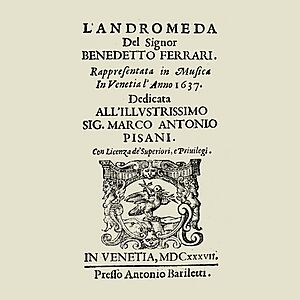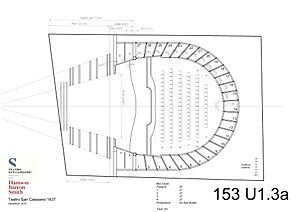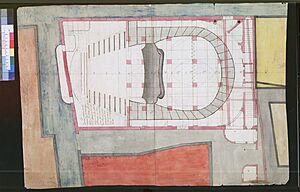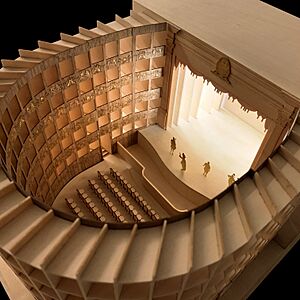Teatro San Cassiano facts for kids
| Teatro Tron | |

Teatro San Cassiano (1637): historically-informed visualisation
|
|
| Location | Venezia |
|---|---|
| Coordinates | 45°26′18.64″N 12°19′49.33″E / 45.4385111°N 12.3303694°E |
| Construction | |
| Built | 1637 |
| Demolished | 1812 |
The Teatro San Cassiano was the world's very first public opera house. It opened in 1637 in Venice, Italy. Before this, opera was mostly for rich people and royalty. The Teatro San Cassiano changed that by letting anyone buy a ticket to watch an opera.
The theatre was owned by the powerful Venetian Tron family. It was named after the area it was in, San Cassiano, which is part of the Santa Croce district. This theatre was a big step for opera, making it available to everyone.
Today, there's a project to rebuild the Teatro San Cassiano in Venice. The goal is to make it look just like it did in 1637. This new theatre will be a place to study and perform old Baroque operas.
Contents
Early History: The 1500s
The first records of a theatre on this spot go back to 1581. The Tron family had a theatre for plays (called commedie). Letters from that time mention this theatre. One letter from Ettore Tron in 1581 talks about spending a lot of money on plays.
— Ettore Tron to duke Alfonso II d’Este, 4 gennaio 1580 more veneto, transcribed I Teatri del Veneto cit., Tomo I, p. 126
This shows that the theatre was popular. It also confirms that it already had "boxes." These were like private viewing areas, which later became a key part of Italian opera house design. Another letter from 1581 also mentions "boxes of those two purpose-built venues."
In 1580, the government (the Council of Ten) started worrying about how strong these new theatres were. They wanted to make sure the buildings were "strong and safe so that no collapse can happen." This was probably because the new box seating changed how theatres were built.
The Tron theatre was closed in 1585 by the Council of Ten. All the wooden parts related to the theatre were removed. It likely reopened after 1607.
The 1600s: Birth of Public Opera
Building the First Public Opera House in 1637
The Teatro San Cassiano was used for plays throughout the 1610s. Sadly, two fires damaged the theatre in 1629 and 1633. There are no records of the theatre from 1634 to 1635.
In 1636, the Tron brothers, Ettore and Francesco, told the authorities they wanted to open a "Theatre for music." This was a huge moment for opera! It meant a theatre was being built just for musical performances.
A document from May 2, 1636, mentions this plan:
With reference to the information given to these Illustrious Magistrates by the Noblemen Tron of San Benetto regarding the intention of opening a Theatre for music, as practiced in some places for the delight of distinguished audiences [...]
We don't have any pictures of the theatre from 1637, inside or out. But we know it opened in 1637 with an opera called L’Andromeda. Francesco Manelli wrote the music, and Benedetto Ferrari wrote the story (libretto).
This event was incredibly important. It started the idea of buying a ticket to see an opera. This idea spread all over the world. The Teatro San Cassiano became the model for Italian opera houses for centuries to come.
How the 1637 Theatre Was Built
Since there are no pictures, we learn about the theatre's inside from old documents. A document from 1657 says the theatre originally had 153 boxes. It's not clear if this was the total number or how many were in use.
In 1683, a French writer named Jacques Chassebras de Cramailles also mentioned 153 boxes. He wrote that the theatre had "five tiers of boxes and 31 in each tier." This means there were four levels with 31 boxes each, plus a ground-floor level (called the 'Pepiano') with 29 boxes. This adds up to 153 boxes.
This number was also recorded by a Venetian architect, Francesco Bognolo, in 1765. He surveyed all the theatres in Venice. Since the theatre's size didn't change much from 1637 to the 1760s, it's believed that the 1637 theatre had 153 boxes over five levels from the very beginning.
Opera Performances and Composers
After L’Andromeda, another opera by Francesco Manelli and Benedetto Ferrari, La maga fulminata, was performed in 1638. From 1639 onwards, Francesco Cavalli became the most important opera composer in Venice.
Cavalli's operas are very important because many of his works from the 1600s still exist today. His opera Le nozze di Teti e di Peleo (1639) is the first complete opera we have for the Teatro San Cassiano. Other famous operas by Cavalli performed here include Gli amori d'Apollo e di Dafne (1640), La Didone (1641), and Giasone (1649).
Other important composers who worked at the Teatro San Cassiano in the 1600s were Pietro Andrea Ziani and Tomaso Albinoni.
The 1700s
Theatre Building and Artistic Life
There's no information about major changes to the theatre building in the first half of the 1700s.
Opera continued to be performed regularly, especially thanks to the composer Tomaso Albinoni. Other well-known composers like Antonio Lotti and Baldassare Galuppi also staged their operas at the Teatro San Cassiano during this time.
Changes in 1763
Before 1765, architect Francesco Bognolo measured all the theatres in Venice. He recorded the exact sizes of the "old" Teatro San Cassiano. The stage was about 6.5 meters deep, and the boxes were quite small, about 95 to 120 centimeters wide.
In 1763, a "new" Teatro San Cassiano opened. The main difference was a deeper stage. This was made possible by tearing down two small houses behind the theatre. The new stage was about 9.5 meters deep, which was 3 meters deeper than before. The boxes were also a bit wider.
Final Years and Demolition
By 1776, the theatre was not as respectable as it once was. The last known season was in 1798, with two operas performed.
In 1805, the French government decided to close the theatre for good. The entire building was torn down in 1812 to make way for new houses. Today, the area where the Teatro San Cassiano once stood is a garden called the Albrizzi garden.
The Reconstruction Project
There is an ongoing project to rebuild the Teatro San Cassiano of 1637 in Venice. This project was started by Paul Atkin. He first thought of the idea in 1999, and serious research began in 2015.
The project officially launched in June 2019 with a conference and exhibition in Venice. The city of Venice supports the project. The group behind the project has found a possible location for the new theatre and is working on the architectural plans.
See also
- Music of Venice
- List of theatres and opera houses in Venice
- Commedia dell'arte





